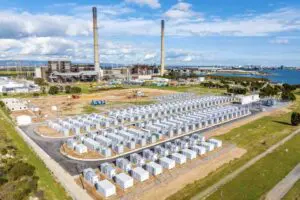Spanish renewable energy company Acciona successfully connected to the grid Spain’s first renewable battery storage plant using recycled batteries from Nissan vehicles, at its experimental solar PV project in the country’s north.
A set of four second-life 32kW/32kWh batteries which started out life in Nissan vehicles were used for the 130kWh battery project, co-located at Acciona’s 1.2 MW solar PV park in Tudela, in Spain’s Navarra region.
The storage plant is the result of a joint project with Spanish battery start-up BeePlanet under the auspices of Acciona’s own innovation program, I’mnovation. BeePlanet, together with ACCIONA, is part of the GERA project, backed by the Government of Navarre, and specialises in energy storage systems using second-life lithium-ion batteries from electric vehicles.
“Second-life batteries can be an ideal option to complement self-consumption facilities, electric vehicle charging networks and microgrids,” said Belén Linares, ACCIONA’s Director of Energy Innovation. “With this, we will be able to prove to our customers our commitment to the circular economy and take a further leap towards decarbonization.”
Acciona will operate the 130kWh battery project from its Renewable Energy Control Center (CECOER) with its global energy management platform GEMS, which enables optimised management, real-time monitoring, and analysis of the storage system’s health.
Reusing electric vehicle lithium-ion batteries is quickly becoming an important part of the conversation, ensuring that the lifecycle of EV batteries – which must remain at over 80% of their operational capacity and only permit a maximum discharge of 5% over 24 hours so as to ensure maximum vehicle performance – is able to extend beyond the effect use in an EV.
Specifically, while electric vehicles need the battery to be operating at peak performance, other battery storage uses are not so demanding, allowing damaged or old EV battery modules to be replaced and then reused in a less demanding situation at a significantly lower cost.
As Acciona points out, reusing an EV battery avoids up to 70% of the CO2 emissions associated with the manufacture of new EV batteries, and also boosts the circular economy model and the recovery of resources – a vitally important component in the lifecycle of energy storage technology, considering the relative scarcity of many of the basic components of lithium-ion batteries, such as cobalt and lithium.
In an article BeePlanet presented earlier this year at the Conference on Sustainable Development of Energy, Water and Environment Systems (SDEWES), the company outlined the science behind the savings in CO2 emissions resulting from reusing batteries.
BeePlanet’s analysis showed that “the main contribution to the cost of CO2 emissions into the atmosphere due to the manufacture of a battery lies mainly on the manufacture of the cells, reaching practically 55% of the total.”
Thus, as the paper describes, “with the manufacture of a second life battery a reduction of up to 75% of CO2 emissions is achieved compared to the manufacture of a new battery.
“As a conclusion, it can be assured that reuse and repurpose are necessary operations to deal with GHG emissions,” BeePlanet concluded.
“Circular economy models must be thus related to green energy generation technologies, sparking the beginnings of a virtuous circle for integral clean technology. In this regard, this paper aimed to demonstrate that second life of batteries from electric vehicles is one of the key factors in achieving a sustainable transition to energy storage at a big scale.”








